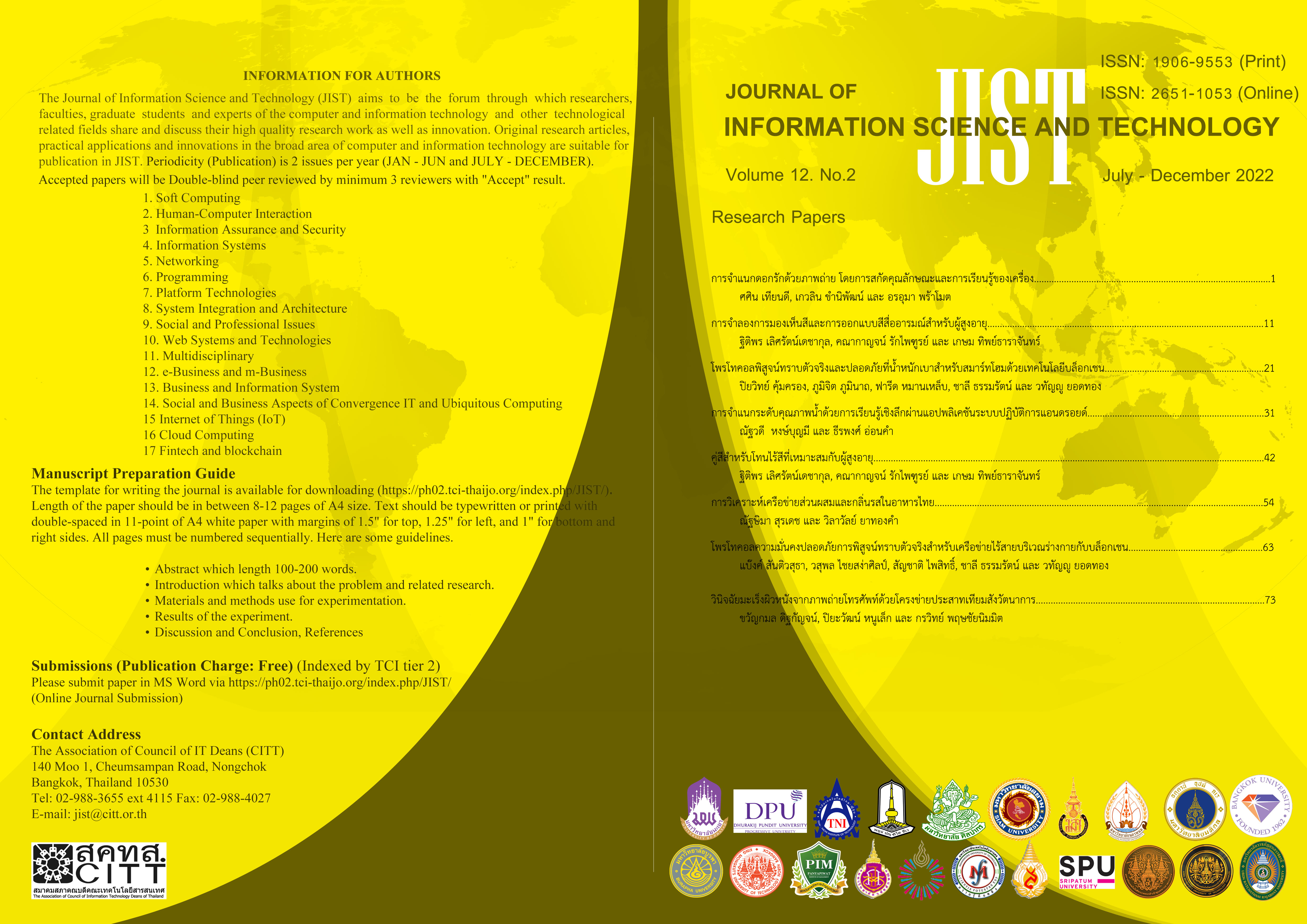Color Combination Pairs of Achromatic Color for the Elderly
Main Article Content
Abstract
Colors help in communicating information and emotions. But effects of aging on vision make difficulty in color discrimination and due to a lot of applications of achromatic color in everyday life, this research therefore focuses on the study of color pairs specific to achromatic color that are suitable for aging vision. A test set of 180 emotionally associated colors from the Color Image Scale were compared to 9 levels of gray in visual discrimination test of the elderly. The test was performed for both gray as the object color and the background color. The results of variation in difficulty of visual discrimination were then analyzed for each color. Finally, we summarize the color groups that can be clearly seen for the different types of grayscale color pairs: 1.black 2.white 3.black and white 4.shadow 5.highlight 6.shadow and highlight 7.all grayscale tone 8.all grayscale tone and black and white 9.all grayscale tone and shadow and highlight. The example of recommended color for the grayscale type 6 (shadow and highlight) is light blue with RGB value of 26,169,206. For the example of recommended color in the case of using with the grayscale type 8 (all grayscale tone and black and white) is orange with RGB value of 227, 109, 74. The summary of the recommended color groups for these nine grayscale color pairs will help to design the color related to achromatic color more appropriately for the elderly.
Article Details
This work is licensed under a Creative Commons Attribution-NonCommercial-NoDerivatives 4.0 International License.
I/we certify that I/we have participated sufficiently in the intellectual content, conception and design of this work or the analysis and interpretation of the data (when applicable), as well as the writing of the manuscript, to take public responsibility for it and have agreed to have my/our name listed as a contributor. I/we believe the manuscript represents valid work. Neither this manuscript nor one with substantially similar content under my/our authorship has been published or is being considered for publication elsewhere, except as described in the covering letter. I/we certify that all the data collected during the study is presented in this manuscript and no data from the study has been or will be published separately. I/we attest that, if requested by the editors, I/we will provide the data/information or will cooperate fully in obtaining and providing the data/information on which the manuscript is based, for examination by the editors or their assignees. Financial interests, direct or indirect, that exist or may be perceived to exist for individual contributors in connection with the content of this paper have been disclosed in the cover letter. Sources of outside support of the project are named in the cover letter.
I/We hereby transfer(s), assign(s), or otherwise convey(s) all copyright ownership, including any and all rights incidental thereto, exclusively to the Journal, in the event that such work is published by the Journal. The Journal shall own the work, including 1) copyright; 2) the right to grant permission to republish the article in whole or in part, with or without fee; 3) the right to produce preprints or reprints and translate into languages other than English for sale or free distribution; and 4) the right to republish the work in a collection of articles in any other mechanical or electronic format.
We give the rights to the corresponding author to make necessary changes as per the request of the journal, do the rest of the correspondence on our behalf and he/she will act as the guarantor for the manuscript on our behalf.
All persons who have made substantial contributions to the work reported in the manuscript, but who are not contributors, are named in the Acknowledgment and have given me/us their written permission to be named. If I/we do not include an Acknowledgment that means I/we have not received substantial contributions from non-contributors and no contributor has been omitted.
References
United Nations, “Ageing,”. [Online]. Available: https://www.un.org/en/global-issues/ageing. [Accessed: Apr. 16, 2022].
Population Reference Bureau, “Countries with the Oldest Populations in the World,”. [Online]. Available: https://www.prb.org/resources/countries-with-the-oldest-populations-in-the-world/. [Accessed: Apr. 16, 2022].
R. Liutkeviciene, D. Cebatoriene, G. Liutkeviciene, V. Jasinskas, and D. Zaliuniene, “Associations between contrast sensitivity and aging,”Medicina (Kaunas),vol. 49, no. 6, pp. 273-277, 2013.
M. A. Jadkowski, “Understanding Recommended Color Contrast,” eldertech.org, Jan. 11, 2017. [Online]. Available: https://eldertech.org/color-contrast-apps-for-older-adults. [Accessed Apr. 16, 2022].
World Wide Web Consortium, “Web Content Accessibility Guidelines (WCAG) 2.1,” 2018. [Online]. Available: https://www.w3.org/TR/WCAG21/. [Accessed Apr. 16, 2022].
Adobe Color, “Contrast Checker,” [Online]. Available: https://color.adobe.com/create/color-contrast-analyzer.[Accessed Apr. 16, 2022].
Institute for Disability Research, Policy, and Practice, “Contrast Checker,”[Online]. Available: https://webaim.org/resources/contrastchecker/.[Accessed Apr. 16, 2022].
P. Pratumrat, “Effects of room illuminance on luminance contrast threshold on LCD for the elderly with cataract,” M. S. thesis, Chulalongkorn University, Bangkok, 2011.
Model Color Palette for Color Universal Design Working Committee, “Model Color Palette for Color Universal Design Guide Book,” 2018. [Online]. Available: https://jfly.uni-koeln.de/colorset/CUD_color_set_GuideBook_2018.pdf [Accessed Apr. 16, 2022].
Google, “Dark Theme,”.[Online]. Available: https://material.io/design/color/dark-theme.html. [Accessed: Apr. 16, 2022].
Google, “Text Legibility,”.[Online]. Available: https://material.io/design/color/text-legibility.html. [Accessed: Apr. 16, 2022].
H. Nagumo, New Color Image Chart. Tokyo, Japan: Graphic-sha, 2016


